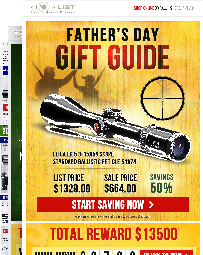Table of Contents
- Introduction
- Decision criteria
- Applications
- FAQ
- What is the best scope for hunting?
- What is the best magnification scope for hunting?
- What scope do you use for deer hunting?
- How much should you spend on a hunting scope?
- What is the best low light hunting scope?
- I have an unusual hunting application that is not listed here. Can you help me?
- I have an unlimited budget and I want the biggest, baddest hunting scope I can get. What should I buy?
- What is a good hunting scope?
- What is the best rifle scope money can buy?
- What is the best bang for your buck hunting scope?
Introduction
Maybe you are a lifelong hunter who harvests more game each year than can fill 5 freezers. Maybe you just got into the sport recently and you have only borrowed a rifle from a friend in the past. Maybe you got that once in a lifetime draw and you want to make absolutely sure you have the right equipment to make the most of your opportunity. No matter what your situation is, you have found yourself overwhelmed with choices for a new scope for your rifle and despite reading everything you can online, watching countless hours of YouTube videos, and talking to your buddies and the local gun shop, you still don’t know where to start. In this article we will discuss exactly how you can find the right scope for your needs.
Decision criteria
Picking the right scope may not sound easy at first. Most hunters will have their favorite brands they swear by, and scope choice can be extremely personal and subjective. Your application, preferences, and requirements may differ from those of other hunters. It can be helpful to pick 2 or 3 criteria that you absolutely need, and then 2 or 3 that you would prefer but are not strictly necessary. Doing so will narrow down the scope of your options (no pun intended) significantly.
Let’s break down the important factors we need to consider when choosing a hunting scope:

Cost
Your budget for a scope is one of the best places to start. You might find the perfect scope for your needs with best in class glass quality by Schmidt & Bender or Swarovski, but if the price point is 5 times higher than you are willing to spend, one of these scopes simply will not work for you. Once we have a price range or budget, we can find appropriate scopes with a reasonable price.
One rule of thumb in the long range shooting world – which is certainly a good place to start with hunting scopes as well – is: Spend as much on your glass as you did on your rifle. You do not want your rifle to be limited by the optic you choose for it. With optics, like with rifles and many other things in life, you get what you pay for. There would be no point in buying a rifle that will shoot a ½ inch group at 100 yards if you can’t even see ½ inch at 100 yards. Of course, most kinds of hunting do not require this kind of precision, but the last thing you want is to make a bad shot, have to track a blood trail for hours, and end up losing your wounded game.
Magnification and magnification ratio
In a perfect world, at 10x zoom, ascope will make your target appear 10 times closer. That is: a target at 200 yards through your scope would look like it is 20 yards away with the naked eye. Of course, glass quality, atmospheric conditions, and other factors don’t always make this calculation perfect, but this is a good place to start. You will also want to keep in mind that your field of view through the scope will also be 10 times smaller than your unmagnified view.
In general, we want to choose a scope that will offer useful magnification throughout its magnification range. In days gone by, a 3-9x variable scope was considered useful for most hunting applications. Today, a 3:1 zoom ratio is fairly small, and many scopes are offered with a 4:1 zoom ratio, 5:1 zoom ratio, 6:1 zoom ratio, or more. With a base magnification of 3x, these ratios would give you a 3-12x, 3-15x, or 3-18x scope respectively. Of course, the trade off we get is a larger size and higher weight, and a higher cost. The wider the magnification range, the wider the application for the scope.
If you primarily expect to be hunting in wooded or brushy areas, and expect to be shooting between 50-200 yards, it can be difficult to justify something like a 4-16x scope. The base magnification of 4x can make it difficult to acquire your target at 50 yards and the higher 16x top end magnification will likely never be used at that distance. In such a situation, something like a 1-4x scope on the low side or 3-12x scope on the high side would likely be much more useful throughout the magnification range.
Likewise, if you are hunting mule deer out west and expect open plains and shooting at 300 yards at a minimum, you will likely not get any use out of a scope with a 3x or 4x base magnification. In this case, a 5-20x or 5-25x scope would likely be better suited.
Objective lens diameter
While objective lens diameter is often overemphasized, it is still an important factor in determining your choice of scope. Many times, scope manufacturers offer the same magnification scope in two different objective lens diameters. Like with magnification, bigger is not always better.
At any given magnification, a larger objective lens will produce a brighter image. A large 50mm or 56mm objective lens is better suited for dawn and dusk hunting, or night hunting, than a smaller 40mm or 44mm lens. That said, a larger objective lens will force you to mount the scope higher on your rifle, in most cases, and can lead to a more top heavy rifle, a higher chance of getting snagged on brush or gear, and even an unattractive rifle.
Most common hunting scopes have between a 40mm and 50mm objective lens, which will work well in most cases. Lower magnification scopes can have lenses between 24mm and 33mm and higher magnification scopes can necessitate 56mm lenses. Keep this in mind when choosing a scope.

Reticle style and focal position
Choosing the right reticle can make or break your hunting scope. The reticle is the first and last thing between you and your target when you are lining up your perfect shot. While you don’t want your reticle obscuring too much of your target, you may find yourself wanting a reticle that can be used for holding over at distance.
Traditionally, most hunting scopes will have some variation of a duplex reticle located in the second focal plane (SFP). This means that the reticle will have heavy posts at 12, 3, 6, and 9 o’clock positions that narrow down to finer crosshairs towards the center of the reticle, and that the reticle always appears the same to you regardless of your magnification. Some variations include a #4 German style, which is similar except it lacks the heavy post at 12 o’clock, a mil dot style reticle, which has milliradian based holds horizontally and vertically, or a simple holdover reticle which would be similar to a duplex but has two or three hash marks for holding over for windage and/or elevation.
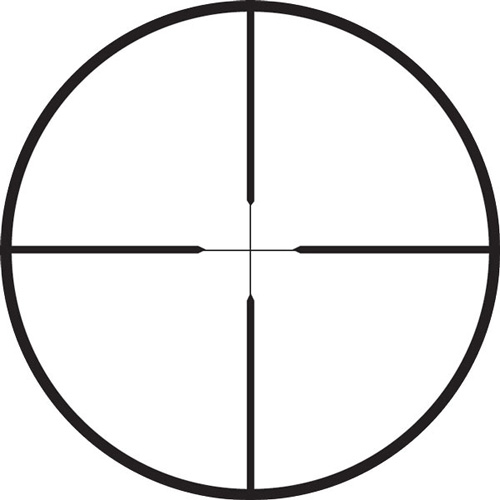
Leupold duplex reticle
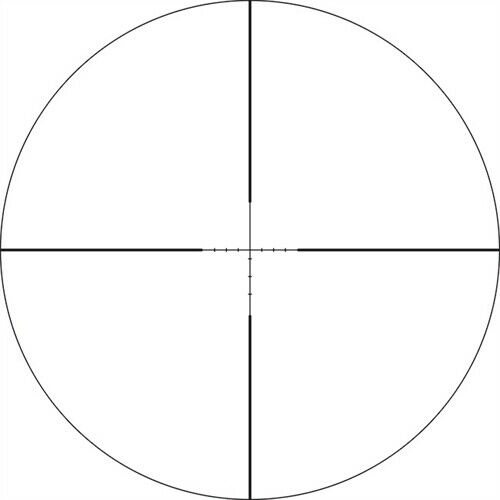
Vortex dead hold BDC reticle
Simple reticles like these usually obscure less of the target and don’t contain too much information that may get in the way. However, second focal plane reticles are only useful for holding over at one magnification setting, usually the highest power. SFP reticles are easy to see and use at the lower end of the magnification range as well.
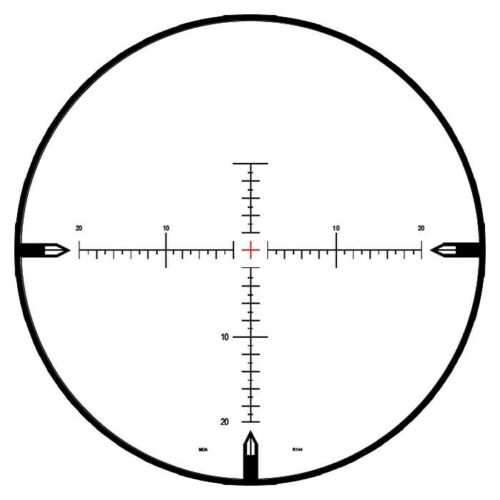
Nightforce MOAR-T reticle
On the other hand, first focal plane (FFP) reticles behave very differently. The reticle size always stays the same in relation to the target, not in relation to your eye. This means that as you zoom in on your scope, your target will appear to get bigger and the reticle will also appear to get bigger at the same rate. This means the reticle is useful for holding over at any magnification, although at the lower end of the magnification the reticle will appear small or fine, and may be more difficult to use at low magnification. Furthermore, FFP reticles tend to be busier with many more hash marks or a grid or Christmas tree pattern for holding over for both distance and windage.
Turret adjustment and style
Turret adjustment and style is often overlooked by many hunters. Most hunting scopes have ¼ MOA (or ¼ inch at 100 yards, ½ inch at 200 yards, etc.) adjustments, but some are available or only offered in 1/10 mil adjustments (1 centimeter at 100 meters, 2 centimeters at 200 meters, etc.). In many cases, the adjustment only matters when you are doing your initial zero, long range applications may require you to adjust your elevation setting, especially if your reticle does not have any holdover features.
Most hunting scopes are found with capped turrets. This means you must unscrew a protective cap over the turret in order to adjust your windage and elevation for zeroing your scope to your rifle. This style is most protective of accidental adjustment in the field if the scope is bumped against gear or brush, and is typically lower profile.

Leupold VX-Freedom scope (note capped turrets)
Exposed turrets are found on some scopes and are typically most useful for longer range applications and target use. Exposed turrets are usually higher profile and have a higher likelihood of getting snagged on brush or gear and the adjustment setting may inadvertently change. Typically exposed turrets are not preferred except for long range applications that do not typically involve carrying the rifle through brush or rough terrain, like long range varmint hunting.
Some exposed turrets have a locking feature that prevents inadvertent adjustment but still allows for quick adjustments to be made in the field. This feature is usually found on tactical scopes and many Leupold scopes. This feature can give you the best of both worlds with the protection of a capped turret and the quick adjustment of a non-locking exposed turret.

Leupold VX-3HD (note exposed elevation turret with silver locking button)
Illumination
Illuminated reticles are not usually found on many hunting scopes, but are growing in popularity. An illuminated reticle will light up red (in most cases) when the illumination is turned on. Somes this red portion of the reticle is just a center dot at the intersection of a duplex reticle, but sometimes the illuminated section can be a cross, a series of dots and/or hash marks, or other patterns.
Illumination can be very helpful when hunting in low light situations, like dusk or dawn or nighttime. Although most hunting scopes do not have a bright enough illumination to be used in full daylight in an open area, having a bit of contrast even in a wooded area during the day can help you place your shot easier. When the illumination is turned off or the battery dies, the reticle still appears black and can be used as normal. Some scopes have clever illumination features such as auto off functions or multiple color choices. Illumination often comes at a higher price and can also make a scope slightly heavier or less streamlined.
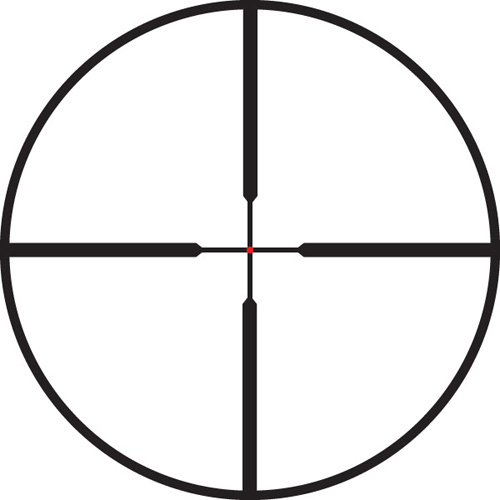
Leupold firedot duplex
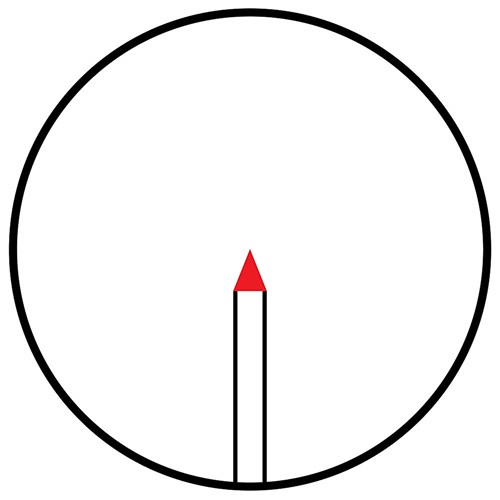
Trijicon red triangle
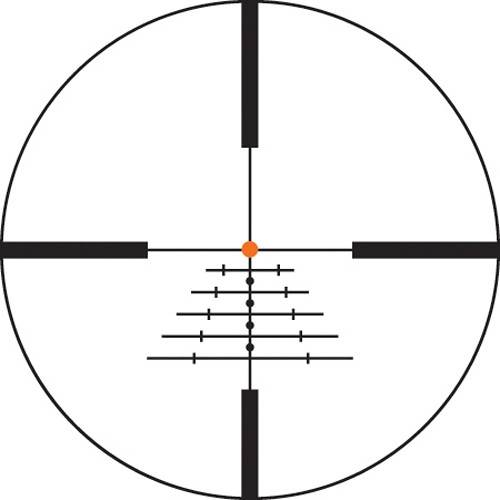
Swarovski BRH-i
Parallax adjustment/focus
Parallax adjustment is another less common feature on hunting scopes that comes from the target shooting world. Parallax adjustment is most useful for longer range shooting as well. Most hunting scopes intended for centerfire rifles have a fixed parallax setting of 100 yards. This means that if you are shooting closer than 100 yards, you can experience parallax error if your eye is not perfectly lined up behind your scope. This is exhibited if you move your eye slightly up, down, left, or right and you notice the reticle position appears to be moving on your target. If you have a fixed parallax scope, this parallax error can be eliminated by shooting only at or further than your fixed parallax distance.
If you are hunting with a rimfire rifle, muzzleloader, or shotgun, you may want to choose a scope with a closer fixed parallax distance of 50 yards or so, as the effective range of these firearms is lower than centerfire rifles, and target distance is often closer than 100 yards.
If you are hunting long range, having an adjustable parallax feature allows you to fine tune your parallax setting and get the most crisp and clearest image at any given distance (within the parallax setting range), which leads to more precise shots.
Weight
The weight of your scope and rifle combo can quickly become a detriment in many kinds of hunting. If you are carrying a heavy rifle for an extended period, especially through rough terrain, your body will be wishing you bought a lighter setup. Usually weight is influenced by many of the above factors, primarily magnification. Scopes with a 1 inch tube are typically lighter than 30mm tube scopes, and 30mm tube scopes are typically lighter than bigger 34mm and larger tube scopes. Extra features such as parallax adjustment and illumination can also add some weight.

Applications
Deer hunting
- Usually between 50 and 300 yards. Look for a scope with a low end magnification of 2x or 3x and high end between 10x and 12x.
- Deer are most active at dawn and dusk, so a larger 50mm objective and reticle illumination can be helpful
- A simple SFP duplex reticle is usually all that is necessary
| Image | Model Name | Price |
|---|---|---|
| Below $500.00 | ||
 |
Leupold VX-3HD 3.5-10x40 1 inch CDS-ZL Duplex SFP Riflescope 180617 | CLICK HERE |
 |
Vortex Viper HS 2.5-10x44 Dead-Hold BDC Reticle Riflescope VHS-4303 | CLICK HERE |
| |
Trijicon Huron 2.5-10x40 BDC Hunter Holds 30mm Satin Black Riflescope 2700002 | CLICK HERE |
| Below $1000.00 | ||
 |
Leupold VX-5HD 3-15x44 CDS-ZL2 Side Focus FireDot Duplex SFP Riflescope 172368 | CLICK HERE |
 |
Swarovski Z3 3-10x42 Non-illuminated Plex SFP Riflescope 59011 | CLICK HERE |
 |
Vortex Razor HD LHT 3-15x42 HSR-5i MOA SFP Riflescope RZR-31501 | CLICK HERE |
| Above $1000.00 | ||
 |
Leupold VX-6HD 2-12x42 30mm CDS-ZL2 Side Focus Illum FireDot Duplex SFP Riflescope 171563 | CLICK HERE |
 |
Schmidt Bender 3-12x50 Klassik LM L3 Black Riflescope 644-811-482-05-05A02 | CLICK HERE |
 |
Swarovski Z5i 2.4-12x50 PLEX-I SFP Riflescope 69770 | CLICK HERE |
Long range big game hunting out west (mule deer, pronghorn, elk, mountain goats, bighorn sheep)
- Usually between 300 and 600 yards. Look for a scope with a high end magnification of 18x to 25x
- Parallax adjustment and exposed elevation turret are usually necessary
- Consider a FFP reticle
- Keep the weight of the scope in mind if the terrain is rough
| Image | Model Name | Price |
|---|---|---|
| Below $500.00 | ||
 |
Vortex Crossfire II 6-24x50 Scope AO Dead-Hold BDC Reticle (MOA) Riflescope CF2-31045 | CLICK HERE |
 |
Leupold VX-Freedom 6-18x40 30mm CDS Side Focus Tri-MOA Riflescope 175081 | CLICK HERE |
 |
Burris Fullfield IV 6-24x50mm Fine Plex Riflescope 200496 | CLICK HERE |
| Below $1000.00 | ||
 |
Vortex Viper HST 6-24x50 VMR-1 MOA SFP Riflescope VHS-4325 | CLICK HERE |
| |
Trijicon Tenmile HX 6-24x50 SFP w/ Red LED Dot MOA Ranging 30mm Satin Black Riflescope 3000003 | CLICK HERE |
 |
Steiner Predator 4 6-24x50 E3 SFP Riflescope 8773 | CLICK HERE |
| Above $1000.00 | ||
 |
Leupold VX-5HD 4-20x52 CDS-ZL2 Side Focus Illum FireDot Duplex SFP Riflescope 178166 | CLICK HERE |
 |
Nightforce SHV 5-20x56 Zeroset Center Illum MOAR SFP Riflescope C535 | CLICK HERE |
 |
Swarovski Z6 5-30x50 BT Plex SFP Riflescope 59910 | CLICK HERE |
Long range varmint hunting (prairie dogs, ground squirrels, etc.)
- Usually between 300 and 600 yards. Due to the smaller target size, consider higher magnification scopes between 25x and 35x.
- Parallax adjustment and exposed elevation turret are necessary
- Weight is usually not as much of an issue
| Image | Model Name | Price |
|---|---|---|
| Below $500.00 | ||
 |
Vortex Diamondback Tactical 6-24x50 EBR-2C MOA FFP Riflescope DBK-10028 | CLICK HERE |
 |
Leupold VX-Freedom 6-18x40 30mm CDS Side Focus Tri-MOA Riflescope 175081 | CLICK HERE |
 |
Burris Fullfield IV 6-24x50mm Fine Plex Riflescope 200496 | CLICK HERE |
| Below $1000.00 | ||
 |
Vortex Viper PST Gen II 5-25x50 EBR-4 MOA SFP Riflescope PST-5251 | CLICK HERE |
 |
Leupold VX-3HD 6.5-20x50 30mm Side Focus CDS-TZL2 Fine Duplex Riflescope 180625 | CLICK HERE |
 |
Meopta Optika6 3-18x50 Illuminated 4C 30mm SFP Riflescope 653642 | CLICK HERE |
| Above $1000.00 | ||
 |
Leupold VX-6HD 3-18x50 30mm CDS-ZL2 Side Focus Illum FireDot Duplex SFP Riflescope 171572 | CLICK HERE |
 |
Nightforce NXS 5.5-22x56 ZeroStop MOAR-T SFP Riflescope C507 | CLICK HERE |
 |
Vortex Razor HD Gen II 3-18x50 EBR-7C MOA FFP Riflescope RZR-31804 | CLICK HERE |
Wild pig
- Can range from 0-300 yards usually
- Depending on distance and your rifle, a low power variable optic (1-4x, 1-6x, etc.) may be useful, especially for close range use on fast moving pigs
- This hunting is often done at night, so reticle illumination is often necessary
| Image | Model Name | Price |
|---|---|---|
| Below $500.00 | ||
 |
Vortex Strike Eagle 1-6x24 AR-BDC3 MOA SFP Riflescope SE-1624-2 | CLICK HERE |
 |
Leupold VX-3HD 2.5-8x36 1 inch CDS-ZL Duplex SFP Riflescope 180616 | CLICK HERE |
 |
Meopta Optika5 2-10x42 Z-Plex Riflescope 1032567 | CLICK HERE |
| Below $1000.00 | ||
 |
Vortex Viper PST Gen II 1-6x24 VMR-2 MOA Riflescope PST-1605 | CLICK HERE |
 |
Leupold VX-5HD 2-10x42 CDS-ZL2 Illum FireDot Duplex SFP Riflescope 171389 | CLICK HERE |
 |
Swarovski Z3 3-9x36 Non-illuminated Plex SFP Riflescope 59031 | CLICK HERE |
| Above $1000.00 | ||
 |
Nightforce NX8 1-8x24mm F1 Riflescope FC-MOA ZeroStop .5 MOA Capped Windage PTL C600 | CLICK HERE |
 |
Leupold VX-6HD 2-12x42 30mm CDS-ZL2 Side Focus Illum FireDot Duplex SFP Riflescope 171563 | CLICK HERE |
 |
Schmidt Bender Zenith 2.5-10x56 FD7 .1mrad CW Riflescope 772-811-707 | CLICK HERE |
Coyote and other predators
- Predators are intelligent and usually fairly wary, so hunting is often done at 200 to 400 yards. Consider a scope with a base magnification of 3x or 4x up to a max of 12x to 16x
- This hunting is often done at night, so reticle illumination is often necessary
- Look for a larger objective lens of 50mm or more
| Image | Model Name | Price |
|---|---|---|
| Below $500.00 | ||
 |
Vortex Diamondback Tactical 4-16x44 EBR-2C MOA FFP Riflescope DBK-10026 | CLICK HERE |
 |
Meopta Optika5 3-15x44 Z-Plus SFP Riflescope 1032573 | CLICK HERE |
 |
Leupold VX-Freedom 4-12x40 30mm CDS Side Focus Tri-MOA Riflescope 175079 | CLICK HERE |
| Below $1000.00 | ||
 |
Leupold VX-5HD 3-15x44 CDS-ZL2 Side Focus FireDot Duplex SFP Riflescope 172368 | CLICK HERE |
 |
Vortex Razor HD LHT 3-15x42 HSR-5i MOA SFP Riflescope RZR-31501 | CLICK HERE |
 |
Meopta Optika6 3-18x50 Illuminated 4C 30mm SFP Riflescope 653642 | CLICK HERE |
| Above $1000.00 | ||
 |
Vortex Razor HD Gen II 3-18x50 EBR-7C MOA FFP Riflescope RZR-31804 | CLICK HERE |
 |
Leupold VX-6HD 3-18x50 30mm CDS-ZL2 Side Focus Illum FireDot Duplex SFP Riflescope 171572 | CLICK HERE |
 |
Schmidt Bender 3-12x50 Klassik LM L3 Black Riflescope 644-811-482-05-05A02 | CLICK HERE |
Best Selling Hunting Scopes in 2021 – Shop Now ›
